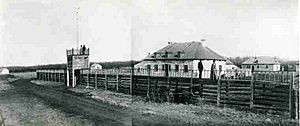Fort Pelly facts for kids
Quick facts for kids Fort Pelly |
|
|---|---|

Fort Pelly in 1887 (second fort)
|
|
| Type | Fort, Military Structure, fur trading post |
| Etymology | Sir John Pelly, governor of the Hudson's Bay Company |
| Location | Pelly, Saskatchewan, Canada |
| Nearest city | Yorkton, Saskatchewan |
| Founder | Hudson's Bay Company |
| Built | First fort 1824 Second fort 1856 |
| Governing body | Parks Canada |
| Website | Parks Canada official website: http://www.pc.gc.ca/eng/lhn-nhs/sk/pelly/index.aspx |
| Designated | 1953 |
Fort Pelly was an important trading post in the Canadian province of Saskatchewan. It was run by the Hudson's Bay Company, a famous fur trading company. People came here to trade animal furs.
The fort was named after Sir John Pelly. He was the governor of the Hudson's Bay Company. Today, the village of Pelly, Saskatchewan, is named after the fort. It is about 8 miles north of where the fort used to be.
Contents
Building the First Fort Pelly
Before Fort Pelly, there was another fort nearby called Fort Hibernia.
The first Fort Pelly was built in 1824. The Hudson's Bay Company built it. It was located in a bend of the Assiniboine River. This spot was great for travel. It was easy to move goods between the Assiniboine and Swan Rivers. This moving point was called a portage. The upper Assiniboine River was shallow and winding. So, it was easier to reach the area from the Swan River.
Fort Pelly was the main office for the Hudson's Bay Company's Swan River District.
What the First Fort Looked Like
The first Fort Pelly had several buildings. There was a dwelling house and a house for Indigenous people. There were also staff houses, a store, and stables. All these buildings were inside a square palisade. A palisade is a strong fence made of tall wooden stakes. This fence was 120 feet on each side.
Alan McDonell was the first chief trader. He chose the spot and watched over the building. The fort traded with Cree and Saulteaux Indigenous people. These nations lived in the area. The fort also hired employees from both groups. In 1841, Fort Pelly had four employees. They lived there with their Métis families.
Challenges and Changes
The first fort was damaged by fire in 1842. But it was rebuilt right away. Cuthbert Cumming was the chief trader then. In 1849, Thomas McKay was born at Fort Pelly. He later became the first mayor of Prince Albert. He was also an important politician in the territory.
Moving to the Second Fort Pelly Site
Fort Pelly was moved in 1856. The new location was about a quarter mile southeast of the first fort. They moved it because the old spot sometimes flooded. The first fort was still used for some things until at least 1859.
Changes in Ownership and Purpose
On July 15, 1870, the Hudson's Bay Company gave its lands to Canada. But the company kept its trading posts. It also kept some land around them. So, the fort was now on block 17 of the Fort Pelly Reserve. Around 1871, Fort Ellice became the main district headquarters. This meant Fort Pelly was less important.
In 1909, the Canadian Northern Railway was built. It was about 6 miles north of Fort Pelly. Because of the railway, trade at the fort almost stopped. Fort Pelly was finally abandoned in June 1912.
Fort Pelly Today
In the summers of 1971 and 1972, people studied the old fort sites. The Saskatchewan Museum of Natural History dug up the areas. They found where all the buildings were. They also found about 7,000 objects.
The site of the first Fort Pelly was named a Historic Site in 1986. This was done by the Province of Saskatchewan. The Saskatchewan Parks Service now looks after it.
The Fort Pelly Historical Society bought the site of the second fort. It was named a National Historic Site of Canada in 1953.

